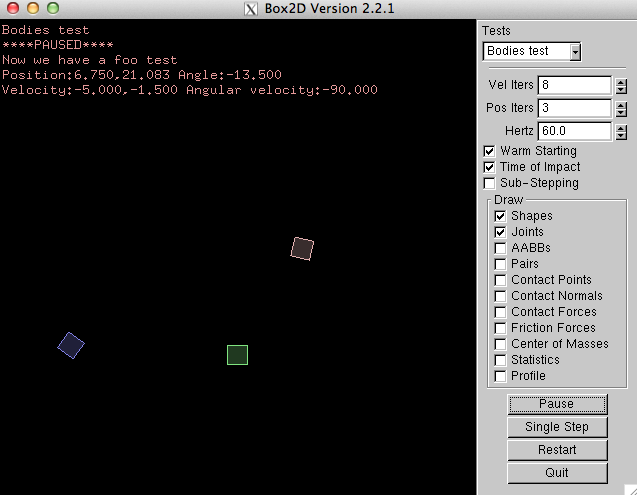- QT Box2D游戏,桌面乒乓球
技术喵
QTBox2D游戏,桌面乒乓球功能:鼠标拖拽右侧球拍,对抗左侧AI,得分在树上。1.球用了小埋的头像2.分数在树上,也有可能滑下来,然后就看不见分数了~源代码:这里ps:如果运行白屏,请把Box2D文件夹拷贝到qt安装目录的Qt\Qt5.5.1\5.5\msvc2010\qml目录下image
- OpenAI Gym 高级教程——可解释性和可视化
Echo_Wish
Python算法Python笔记python算法开发语言分布式
PythonOpenAIGym高级教程:可解释性和可视化在本篇博客中,我们将深入探讨OpenAIGym高级教程,聚焦于强化学习模型的可解释性和可视化。我们将使用解释性工具和数据可视化方法,以便更好地理解模型的决策过程和性能。1.安装依赖首先,确保你已经安装了OpenAIGym以及一些常用的数据处理、可视化库:pipinstallgym[box2d]numpymatplotlibseaborn2.解
- 2D 物理引擎调研及游戏中的应用
fananchong2
服务器3D场景建模游戏2d物理引擎碰撞检测包围盒查询场景建模
Box2DVSChipmunk2D这里说的都是Golang版本Box2D:https://github.com/ByteArena/box2dChipmunk2D:https://github.com/jakecoffman/cp功能对比:功能Box2DChipmunk2D场景构建YY绑定userdataYY墙体YY包围盒查询YY射线检测YY查询算法AdynamicAABBtreeaboundin
- OpenAI Gym 高级教程——分布式训练与并行化
Echo_Wish
Python笔记Python算法分布式
PythonOpenAIGym高级教程:分布式训练与并行化在本篇博客中,我们将深入探讨OpenAIGym高级教程,特别关注分布式训练与并行化的方法。我们将使用Ray这个强大的分布式计算库来实现并行化训练。1.安装依赖首先,确保你已经安装了OpenAIGym和Ray:pipinstallgym[box2d]ray2.Ray的初始化在使用Ray进行并行化训练之前,需要初始化Ray。下面是一个简单的初始
- OpenAI Gym 中级教程——强化学习实践项目
Echo_Wish
Python算法Python笔记pythonscipy算法
PythonOpenAIGym中级教程:强化学习实践项目在本篇博客中,我们将通过一个实际项目来演示如何在OpenAIGym中应用强化学习算法。我们选择一个简单而经典的问题:CartPole,这是一个控制小车平衡杆的问题。我们将使用深度Q网络(DQN)算法来解决这个问题。1.安装依赖首先,确保你已经安装了必要的依赖:pipinstallgym[box2d]tensorflow2.强化学习项目实践2.
- 2018-12-26
w123_sz
函数cv2.minAreaRect()返回一个Box2D结构rect:(最小外接矩形的中心(x,y),(宽度,高度),旋转角度)。
- 射线与AABB相交检测
[奋斗不止]
3D数学基础图形射线与AABB相交检测
Box2D使用了一个叫做slab的碰撞检测算法。在2D中AABB是一个矩形边界框,slab指的是矩形一组平行线之间的范围,所以在2D中矩形边界框四条边,两两一组,可以组成两个slab。如下图:平行于Y轴的两条边(紫色线)之间的范围是x-slab,范围无限长,宽度限制在两条紫色线之间平行于X轴的两条边(红色线)之间的范围是y-slab,范围无限长,宽度限制在两条红色线之间中间灰色比较深的部分就是矩形
- [python]gym安装报错ERROR: Failed building wheel for box2d-py
FL1623863129
Pythonpython开发语言
报错截图:box2d是一个游戏领域的2D图形C++引擎,用来模拟2D刚体物体运动和碰撞。swig是一个将c/c++代码封装为Python库的工具(是Python调用c/c++库的一种常见手段),所以在运行时box2d会依赖到swig。而swig并不是一个python库,应该说算是一个系统级别的库,所以,在初次构建依赖到gym的Python项目时就会遇到“ERROR:Failedbuildingwh
- Unity优化——加速物理引擎1
七七喝椰奶
Unity优化Unityunity游戏引擎
大家好,这里是七七,今天开始更新物理引擎相关的优化部分了,本文介绍的是物理引擎内部工作情况。Unity技术有两种不同的物理引擎:用于3D物理的Nvidia的PhysX和用于2D物理的开源项目Box2D。然而,Unity对它们的实现是高度抽象的,从通过主Unity引擎配置的更高级别UnityAPI的角度来看,两个物理引擎解决方案以功能相同的方式运行。无论是哪种情况,对Unity的物理引擎了解的越多,
- laya2D射线检测
crazy_yun
layabox游戏程序射线检测laya
虽然laya的libs声明文件中Laya.physics.I.world为any类型,但通过查看源码我们就能发现laya的2D物理采用的是Box2D,点击进入。把Laya.physics.I.world输出到控制台我们可以发现这个是laya.physics.js文件中的b2World类型,而且有对应的射线检测方法,如下图通过搜索raycast关键字我们可以发现laya已经在box2d.d.ts声明
- Box2d 物理画线,Cocos Creator 3.8
白玉无冰 lamyoung
一个简易的画线刚体Demo效果抱歉,放错图了,以上是孙二喵iwaehttps://forum.cocos.org/t/topic/142673[1]的效果图。本Demo是根据文章的思路,合成的代码。首先,感谢孙二喵的技术分享。以下是最终效果图使用版本CocosCreator3.8.1创建一个Empty(2D)项目保存场景,新建一个Game.ts脚本,把代码复制进去(代码在最后面)拖入Game.ts
- 安装gymnasium[box2d]的问题
Chen_Chance
python开发语言
安装时总会报错Buildingwheelsforcollectedpackages:box2d-pyBuildingwheelforbox2d-py(setup.py)...errorerror:subprocess-exited-with-error×pythonsetup.pybdist_wheeldidnotrunsuccessfully.│exitcode:1╰─>[16linesofou
- 强化学习问题(二)--- ERROR: Failed building wheel for box2d-py
笑傲江湖2023
python开发语言
错误:Couldnotbuildwheelsforbox2d-py,whichisrequiredtoinstallpyproject.toml-basedprojectspyproject.toml-basedprojects:意思是缺少依赖包,对于box2d就是缺少swig注意:安装python对应的swig版本解决1:直接输入condainstallswig解决2:从该地址下载压缩包,再安装
- OpenAI Gym Note
dragonchow123
AI人工智能
安装:pipinstallgym#基础版pipinstallpygamecondainstall-cconda-forgebox2d-py#或者pipinstallgym[box2d]atari安装问题1,zsh问题pipinstallgym[atari]error:找不到‘gym[atari]’解决办法:vim~/.zshrc最后一行加上:setoptno_nomatchsource~/.zsh
- 隐秘的物理粒子系统与渲染 !Cocos Creator LiquidFun !
白玉无冰
隐秘的物理粒子系统与渲染!CocosCreatorLiquidFun!让cocosQ弹起来!物理流体之LiquidFun流体纹理shader!效果预览imagehttps://www.bilibili.com/video/BV1hD4y127H2/原理物理粒子系统引擎内置的box2d.js其实已经携带了google的liquidfun(但是没有公开接口和适配)。并且引擎还对box2d做了一次适配,
- 【C++】开源:Box2D动力学库配置与使用
Frank学习路上
#c++开源项目学习c++开源开发语言
★,°:.☆( ̄▽ ̄)/$:.°★这篇文章主要介绍Box2D动力学库配置与使用。无专精则不能成,无涉猎则不能通。——梁启超欢迎来到我的博客,一起学习,共同进步。喜欢的朋友可以关注一下,下次更新不迷路文章目录:smirk:1.项目介绍:blush:2.环境配置:satisfied:3.使用说明1.项目介绍项目Github地址:https://github.com/erincatto/box2d官网:
- Cocos2d-x Box2D物理引擎编译设置
weixin_30407613
找到解决方案TestCpp工程。打开其属性=》C/C++=》预处理器==》处理器定义。参加“CC_ENABLE_BOX2D_INTEGRATION=1”,更改“CC_ENABLE_CHIPMUNK_INTEGRATION=0”,打开libExtensions项目相同找到预处理器定义,加入“CC_ENABLE_BOX2D_INTEGRATION=1”,删除“CC_ENABLE_CHIPMUNK_IN
- Qt 5.10 集成 Box2D 物理引擎
weixin_30624825
uic/c++移动开发
集成环境:Windows7x64Qt5.10.0x32Box2D是一个强大的开源物理游戏引擎,用来模拟2D刚体物体运动和碰撞,由ErinCatto早在2007年用C++语言开发。Box2D集成了大量的物理力学和运动学的计算,并将物理模拟过程封装到类对象中,将对物体的操作,以简单友好的接口提供给开发者。我们只需要调用引擎中相应的对象或函数,就可以模拟现实生活中的加速、减速、抛物线运动、万有引力、碰撞
- box2d 碰撞检测_实例介绍Cocos2d-x中Box2D物理引擎:碰撞检测
Killer Seven
box2d碰撞检测
在Box2D中碰撞事件通过实现b2ContactListener类函数实现,b2ContactListener是Box2D提供的抽象类,它的抽象函数:virtualvoidBeginContact(b2Contact*contact)。两个物体开始接触时会响应,但只调用一次。virtualvoidEndContact(b2Contact*contact)。分离时响应。但只调用一次。virtualv
- python box2d使用_python下的Box2d物理引擎的配置
weixin_39528525
pythonbox2d使用
Icomeback!由于已经大四了,正在找工作导致了至今以来第二长的时间内没有更新博客。向大家表示道歉前言Box2d物理引擎Box2d是一款开源的2d物理引擎,存在很多的版本,C++,Java,html5和python等等著名的愤怒的小鸟就是使用了这款物理引擎进行开发的目前也有很多的2d游戏引擎内置了对Box2d物理引擎的支持,比如cocos2d,HTML5的2D游戏引擎FLAGBox2d物理引擎
- Box2D在VS2010上面的配置
FreeNolan
Box2DBox2D配置vs2010
最近自己有兴趣,就捣鼓Box2D,在网上找了一些配置的方法,但是都有一些问题,这里自己在尝试借鉴一些方法后,我自己可行的配置方法首先,需要在http://box2d.org/上面下载最新的Box2D解压出来后,我们将文件夹的名字改为“Box2DSDK”(避免_等特殊符号),解压出来的目录如下:接下来,我们编译Build/vs2010中的Box2D.sln,在bin/Debug中生成Box2D.li
- Box2D C++ 教程-环境设置
superman000001
Box2DC++教程box2dc++教程cocos2d-x游戏引擎
转载文章:原帖地址:http://ohcoder.com/blog/2012/11/29/setting-up/声明:本文翻译自Box2DC++tutorial-Settingup,仅供学习参考。环境设置包括三种主流系统:-Windows-Linux-Mac由于最新的Box2D版本,源码中针对Windows和Mac平台中的主流IDE(VS2010和XCode4)已经进行了整合,所以这里就不进行翻译
- cocos中的Box2d物理引擎
pur_e
cocos2dxcocosbox2d物理引擎
原文地址:http://wwk.iteye.com/blog/1722124一些Box2d的基本概念,一些cocos中使用box2d需要注意的地方1.cocos2d自带了两套物理引擎:Box2D和Chipmunk。两套引擎都是为2D游戏设计的,可以和cocos2d完美整合。Box2D是用C++写的,而Chipmunk用的是C。Box2D中的变量和方法名都是用全称命名的,Chipmunk中很多地方用
- (译)在cocos2d里面如何使用物理引擎box2d:弹球
dearbaba_8520
2d引擎box2diphone游戏开发cocos2d如何cocos
原文地址为:(译)在cocos2d里面如何使用物理引擎box2d:弹球免责申明(必读!):本博客提供的所有教程的翻译原稿均来自于互联网,仅供学习交流之用,切勿进行商业传播。同时,转载时不要移除本申明。如产生任何纠纷,均与本博客所有人、发表该翻译稿之人无任何关系。谢谢合作!原文链接地址:http://www.raywenderlich.com/457/intro-to-box2d-with-coco
- C++物理引擎Box2D的下载,编译,VS2013配置环境
百口可乐__
C/C++NotFreec++开发语言
文章目录网站和下载地址编译工具:编译box2dhelloworld测试网站和下载地址https://box2d.org/下载地址https://hub.nuaa.cf/erincatto/box2d/tags编译工具:1.VS20132.cmake下载地址https://cmake.org/编译box2d下载box2d源码2.4.0,解压。在box2d-2.4.0目录下建立一个build文件夹。用
- Could not build wheels for box2d-py, which is required to install pyproject.toml-based projects
RUIWENLI
ubuntu
问题:ubuntu中使用Anaconda安装gym[box2d]报错。解决:安装依赖包condainstallswig后再次安装
- 解决安装强化学习库gymnasium,box2d安装报错的问题
tortorish
python人工智能
gymnasium是强化学习的库,比较难安装。一、安装方法安装Gymnasium(一定要all,这样可以安装所有依赖)pipinstallgymnasium[all]pipinstallgymnasium[all]二、报错信息一:ERROR:Couldnotbuildwheelsforbox2d-py,whichisrequiredtoinstallpyproject.toml-basedproj
- unity物理系统
J-SL
unity基础unity游戏引擎
物理引擎即描述真实世界中物理现象的算法,如刚体物理,软体物理和流体物理,unity本身支持的主要为刚体物理,我们也可以自己编写一些其它的模拟效果。unity内置Nvidia开发的Physx引擎(3D)和一个开源引擎Box2D,它们是共存的但不能作用在同一个物体身上。引擎的功能主要是1.碰撞检测2.刚体动力学模拟在unity中每一次物理更新会发生:1.调用FixedUpdate2.唤醒所以yield
- Python深度强化学习实战 ——OpenAI Gym-CarRacing自动驾驶项目
柠檬叶子C
python自动驾驶网络安全
写在前面:本篇是关于OpenAIGym-CarRacing自动驾驶项目的博客,面向掌握Python并有一定的深度强化学习基础的读者。GYM-Box2DCarRacing是一种在OpenAIGym平台上开发和比较强化学习算法的模拟环境。它是流行的Box2D物理引擎的一个版本,经过修改以支持模拟汽车在赛道上行驶的物理过程。本篇是CarRacing系列博客的代码篇,提供lane_dection部分的完整
- 关于Box2d安装问题及python查看支持的库的版本号万能解决办法。
葡萄园I
python开发语言后端
直接用pipdebug--verbose查看支持的包的版本号Python语法问题-module‘pip._internal‘hasnoattribute‘pep425tags‘.原因及解决办法,32位、64位查看pip支持万能方法_小蓝枣的博客-CSDN博客新方法篇:直接用pipdebug--verbose命令即可看pip支持。常规方法篇:64位pip老的查看方法前段时间更新后就不能用了。之前导入
- 深入浅出Java Annotation(元注解和自定义注解)
Josh_Persistence
Java Annotation元注解自定义注解
一、基本概述
Annontation是Java5开始引入的新特征。中文名称一般叫注解。它提供了一种安全的类似注释的机制,用来将任何的信息或元数据(metadata)与程序元素(类、方法、成员变量等)进行关联。
更通俗的意思是为程序的元素(类、方法、成员变量)加上更直观更明了的说明,这些说明信息是与程序的业务逻辑无关,并且是供指定的工具或
- mysql优化特定类型的查询
annan211
java工作mysql
本节所介绍的查询优化的技巧都是和特定版本相关的,所以对于未来mysql的版本未必适用。
1 优化count查询
对于count这个函数的网上的大部分资料都是错误的或者是理解的都是一知半解的。在做优化之前我们先来看看
真正的count()函数的作用到底是什么。
count()是一个特殊的函数,有两种非常不同的作用,他可以统计某个列值的数量,也可以统计行数。
在统
- MAC下安装多版本JDK和切换几种方式
棋子chessman
jdk
环境:
MAC AIR,OS X 10.10,64位
历史:
过去 Mac 上的 Java 都是由 Apple 自己提供,只支持到 Java 6,并且OS X 10.7 开始系统并不自带(而是可选安装)(原自带的是1.6)。
后来 Apple 加入 OpenJDK 继续支持 Java 6,而 Java 7 将由 Oracle 负责提供。
在终端中输入jav
- javaScript (1)
Array_06
JavaScriptjava浏览器
JavaScript
1、运算符
运算符就是完成操作的一系列符号,它有七类: 赋值运算符(=,+=,-=,*=,/=,%=,<<=,>>=,|=,&=)、算术运算符(+,-,*,/,++,--,%)、比较运算符(>,<,<=,>=,==,===,!=,!==)、逻辑运算符(||,&&,!)、条件运算(?:)、位
- 国内顶级代码分享网站
袁潇含
javajdkoracle.netPHP
现在国内很多开源网站感觉都是为了利益而做的
当然利益是肯定的,否则谁也不会免费的去做网站
&
- Elasticsearch、MongoDB和Hadoop比较
随意而生
mongodbhadoop搜索引擎
IT界在过去几年中出现了一个有趣的现象。很多新的技术出现并立即拥抱了“大数据”。稍微老一点的技术也会将大数据添进自己的特性,避免落大部队太远,我们看到了不同技术之间的边际的模糊化。假如你有诸如Elasticsearch或者Solr这样的搜索引擎,它们存储着JSON文档,MongoDB存着JSON文档,或者一堆JSON文档存放在一个Hadoop集群的HDFS中。你可以使用这三种配
- mac os 系统科研软件总结
张亚雄
mac os
1.1 Microsoft Office for Mac 2011
大客户版,自行搜索。
1.2 Latex (MacTex):
系统环境:https://tug.org/mactex/
&nb
- Maven实战(四)生命周期
AdyZhang
maven
1. 三套生命周期 Maven拥有三套相互独立的生命周期,它们分别为clean,default和site。 每个生命周期包含一些阶段,这些阶段是有顺序的,并且后面的阶段依赖于前面的阶段,用户和Maven最直接的交互方式就是调用这些生命周期阶段。 以clean生命周期为例,它包含的阶段有pre-clean, clean 和 post
- Linux下Jenkins迁移
aijuans
Jenkins
1. 将Jenkins程序目录copy过去 源程序在/export/data/tomcatRoot/ofctest-jenkins.jd.com下面 tar -cvzf jenkins.tar.gz ofctest-jenkins.jd.com &
- request.getInputStream()只能获取一次的问题
ayaoxinchao
requestInputstream
问题:在使用HTTP协议实现应用间接口通信时,服务端读取客户端请求过来的数据,会用到request.getInputStream(),第一次读取的时候可以读取到数据,但是接下来的读取操作都读取不到数据
原因: 1. 一个InputStream对象在被读取完成后,将无法被再次读取,始终返回-1; 2. InputStream并没有实现reset方法(可以重
- 数据库SQL优化大总结之 百万级数据库优化方案
BigBird2012
SQL优化
网上关于SQL优化的教程很多,但是比较杂乱。近日有空整理了一下,写出来跟大家分享一下,其中有错误和不足的地方,还请大家纠正补充。
这篇文章我花费了大量的时间查找资料、修改、排版,希望大家阅读之后,感觉好的话推荐给更多的人,让更多的人看到、纠正以及补充。
1.对查询进行优化,要尽量避免全表扫描,首先应考虑在 where 及 order by 涉及的列上建立索引。
2.应尽量避免在 where
- jsonObject的使用
bijian1013
javajson
在项目中难免会用java处理json格式的数据,因此封装了一个JSONUtil工具类。
JSONUtil.java
package com.bijian.json.study;
import java.util.ArrayList;
import java.util.Date;
import java.util.HashMap;
- [Zookeeper学习笔记之六]Zookeeper源代码分析之Zookeeper.WatchRegistration
bit1129
zookeeper
Zookeeper类是Zookeeper提供给用户访问Zookeeper service的主要API,它包含了如下几个内部类
首先分析它的内部类,从WatchRegistration开始,为指定的znode path注册一个Watcher,
/**
* Register a watcher for a particular p
- 【Scala十三】Scala核心七:部分应用函数
bit1129
scala
何为部分应用函数?
Partially applied function: A function that’s used in an expression and that misses some of its arguments.For instance, if function f has type Int => Int => Int, then f and f(1) are p
- Tomcat Error listenerStart 终极大法
ronin47
tomcat
Tomcat报的错太含糊了,什么错都没报出来,只提示了Error listenerStart。为了调试,我们要获得更详细的日志。可以在WEB-INF/classes目录下新建一个文件叫logging.properties,内容如下
Java代码
handlers = org.apache.juli.FileHandler, java.util.logging.ConsoleHa
- 不用加减符号实现加减法
BrokenDreams
实现
今天有群友发了一个问题,要求不用加减符号(包括负号)来实现加减法。
分析一下,先看最简单的情况,假设1+1,按二进制算的话结果是10,可以看到从右往左的第一位变为0,第二位由于进位变为1。
- 读《研磨设计模式》-代码笔记-状态模式-State
bylijinnan
java设计模式
声明: 本文只为方便我个人查阅和理解,详细的分析以及源代码请移步 原作者的博客http://chjavach.iteye.com/
/*
当一个对象的内在状态改变时允许改变其行为,这个对象看起来像是改变了其类
状态模式主要解决的是当控制一个对象状态的条件表达式过于复杂时的情况
把状态的判断逻辑转移到表示不同状态的一系列类中,可以把复杂的判断逻辑简化
如果在
- CUDA程序block和thread超出硬件允许值时的异常
cherishLC
CUDA
调用CUDA的核函数时指定block 和 thread大小,该大小可以是dim3类型的(三维数组),只用一维时可以是usigned int型的。
以下程序验证了当block或thread大小超出硬件允许值时会产生异常!!!GPU根本不会执行运算!!!
所以验证结果的正确性很重要!!!
在VS中创建CUDA项目会有一个模板,里面有更详细的状态验证。
以下程序在K5000GPU上跑的。
- 诡异的超长时间GC问题定位
chenchao051
jvmcmsGChbaseswap
HBase的GC策略采用PawNew+CMS, 这是大众化的配置,ParNew经常会出现停顿时间特别长的情况,有时候甚至长到令人发指的地步,例如请看如下日志:
2012-10-17T05:54:54.293+0800: 739594.224: [GC 739606.508: [ParNew: 996800K->110720K(996800K), 178.8826900 secs] 3700
- maven环境快速搭建
daizj
安装mavne环境配置
一 下载maven
安装maven之前,要先安装jdk及配置JAVA_HOME环境变量。这个安装和配置java环境不用多说。
maven下载地址:http://maven.apache.org/download.html,目前最新的是这个apache-maven-3.2.5-bin.zip,然后解压在任意位置,最好地址中不要带中文字符,这个做java 的都知道,地址中出现中文会出现很多
- PHP网站安全,避免PHP网站受到攻击的方法
dcj3sjt126com
PHP
对于PHP网站安全主要存在这样几种攻击方式:1、命令注入(Command Injection)2、eval注入(Eval Injection)3、客户端脚本攻击(Script Insertion)4、跨网站脚本攻击(Cross Site Scripting, XSS)5、SQL注入攻击(SQL injection)6、跨网站请求伪造攻击(Cross Site Request Forgerie
- yii中给CGridView设置默认的排序根据时间倒序的方法
dcj3sjt126com
GridView
public function searchWithRelated() {
$criteria = new CDbCriteria;
$criteria->together = true; //without th
- Java集合对象和数组对象的转换
dyy_gusi
java集合
在开发中,我们经常需要将集合对象(List,Set)转换为数组对象,或者将数组对象转换为集合对象。Java提供了相互转换的工具,但是我们使用的时候需要注意,不能乱用滥用。
1、数组对象转换为集合对象
最暴力的方式是new一个集合对象,然后遍历数组,依次将数组中的元素放入到新的集合中,但是这样做显然过
- nginx同一主机部署多个应用
geeksun
nginx
近日有一需求,需要在一台主机上用nginx部署2个php应用,分别是wordpress和wiki,探索了半天,终于部署好了,下面把过程记录下来。
1. 在nginx下创建vhosts目录,用以放置vhost文件。
mkdir vhosts
2. 修改nginx.conf的配置, 在http节点增加下面内容设置,用来包含vhosts里的配置文件
#
- ubuntu添加admin权限的用户账号
hongtoushizi
ubuntuuseradd
ubuntu创建账号的方式通常用到两种:useradd 和adduser . 本人尝试了useradd方法,步骤如下:
1:useradd
使用useradd时,如果后面不加任何参数的话,如:sudo useradd sysadm 创建出来的用户将是默认的三无用户:无home directory ,无密码,无系统shell。
顾应该如下操作:
- 第五章 常用Lua开发库2-JSON库、编码转换、字符串处理
jinnianshilongnian
nginxlua
JSON库
在进行数据传输时JSON格式目前应用广泛,因此从Lua对象与JSON字符串之间相互转换是一个非常常见的功能;目前Lua也有几个JSON库,本人用过cjson、dkjson。其中cjson的语法严格(比如unicode \u0020\u7eaf),要求符合规范否则会解析失败(如\u002),而dkjson相对宽松,当然也可以通过修改cjson的源码来完成
- Spring定时器配置的两种实现方式OpenSymphony Quartz和java Timer详解
yaerfeng1989
timerquartz定时器
原创整理不易,转载请注明出处:Spring定时器配置的两种实现方式OpenSymphony Quartz和java Timer详解
代码下载地址:http://www.zuidaima.com/share/1772648445103104.htm
有两种流行Spring定时器配置:Java的Timer类和OpenSymphony的Quartz。
1.Java Timer定时
首先继承jav
- Linux下df与du两个命令的差别?
pda158
linux
一、df显示文件系统的使用情况,与du比較,就是更全盘化。 最经常使用的就是 df -T,显示文件系统的使用情况并显示文件系统的类型。 举比例如以下: [root@localhost ~]# df -T Filesystem Type &n
- [转]SQLite的工具类 ---- 通过反射把Cursor封装到VO对象
ctfzh
VOandroidsqlite反射Cursor
在写DAO层时,觉得从Cursor里一个一个的取出字段值再装到VO(值对象)里太麻烦了,就写了一个工具类,用到了反射,可以把查询记录的值装到对应的VO里,也可以生成该VO的List。
使用时需要注意:
考虑到Android的性能问题,VO没有使用Setter和Getter,而是直接用public的属性。
表中的字段名需要和VO的属性名一样,要是不一样就得在查询的SQL中
- 该学习笔记用到的Employee表
vipbooks
oraclesql工作
这是我在学习Oracle是用到的Employee表,在该笔记中用到的就是这张表,大家可以用它来学习和练习。
drop table Employee;
-- 员工信息表
create table Employee(
-- 员工编号
EmpNo number(3) primary key,
-- 姓


